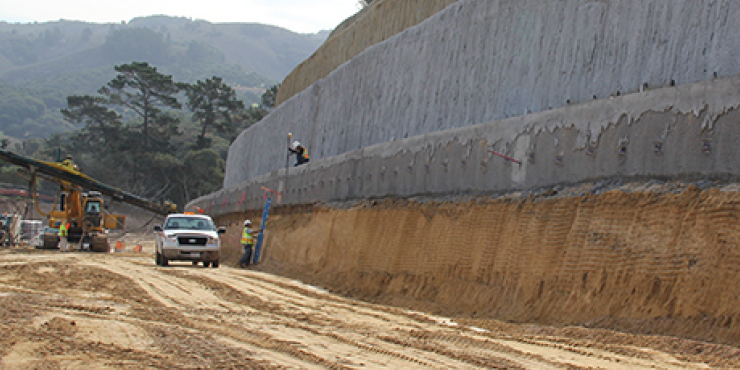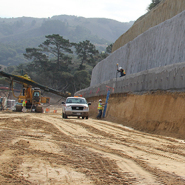Projects
Graniterock makes Monterey Airport safer for takeoff and landing
Longtime Graniterock field SupervisorGary Whitmire says the safety improvement project underway at the Monterey Airport might be the most challenging of his 35-year career.“It’s a good project, but it’s also very challenging because of the verticalness and the size restraints,” Gary said. “There’s so much planning and thought going into this job. All projects are a puzzle to be built, but this one’s a little more challenging on multiple fronts than normal.”
Graniterock’s Construction Division landed the $30 million Runway Safety Area improvement project, bid by estimators Bob Williams and Randy Bonino, in early 2014.
The project is similar to the Company’s joint venture projectat San Francisco International Airport completed in August 2014.
The projects are part of a mandate by the Federal Aviation Administration to meet new runway safety standards by December 2015. All airports across the country must comply.
Since May, crews have been working on the east end of Monterey’s runway, visible to Highway 68, to build a series of retaining walls in preparation of installing blocks made of a special concrete designed to arrest or slow an airplane unable to stop with normal braking.
Nearly 4,000 EMAS blocks – Engineered Materials Arrestor System – will be installed on each end.
In preparing the runway for major construction, a series of retaining walls must be built on each end.
A 100-foot-tall terraced retaining wall with pavers is about two-thirds complete. Also going up are six terraced soil nail retaining walls – 100 feet tall and 1,000 feet long - sculpted with shotcrete and stained to look like sand bluffs and blend in with the natural environment.
Graniterock crews will work24/7 beginning Jan. 19 for roughly 60 days, to construct the necessary improvements that impact the runway and install the EMAS blocks. That will be a particularly challenging juncture in the project as the airport’s instrument landing system will be shut down while the work takes place.
Gary said he expects the team to begin working Phase II, the west end of the runway, in March.
In addition to the retaining walls and EMAS blocks, the project calls for relocating andconstructing the two service roads around the airport’s perimeter to be used by airport police, fire and maintenance vehicles.
Finding sufficient water for compaction on the job has been a significant challenge. Without many options for a water source that could provide the necessary 90,000 gallons a day, Gary turned to many sources to secure the needed water. This required a lot of brainstorming from the team.
This project calls for a large number of crew members, including Magdaleno Cervantez, Grady Crawford, Jeremy Dennis, Antonio Guevara, Gary Hartranft, Joey Martin, Salvador Jauregui, Jr., Russell Jordan, Eduardo Juarez, Thomas Kachel, Jason Lauderdale, Jose Magallanes Neri, Joseph Martin, Ramiro Martinez, Dominic Pirozzoli, William Pumphrey, Pablo Ramirez, Cipriano Rivera, Juan Rocha, Travis Sakamoto, Abraham Tirado, Eric Travers, Timothy Watlington, Stephen Whitmire, Jason Smyth, Edward Briggs, William Luker, Marc Burrell, Christopher Gipe-Perez, Justin Madrid, Clint Shirk, Darien Shirk, Miguel Gallegos Negrete, Samuel Jordan, Eduardo Juarez, Ramiro Martinez and Pablo Romo.
In addition, thanks goes to Kevin Jones for facilitating concrete crew flexibility, to Brent Edelman for keeping the crews and equipment available and to Israel Alvarez for his sharp equipment maintenance.


